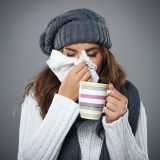

The flu is a contagious infection that affects the respiratory system and is caused by the influenza virus. Influenza, or the flu, can be a very serious disease that can result in complications such as pneumonia, bronchitis or sinus and ear infections – and may even result in hospitalization or death in those with weakened immune systems. Young children and the elderly are at particular risk, along with anyone with a weakened immune system.
Experts warn that the flu virus can be spread by small droplets when infected people cough or sneeze, spreading the virus in an area about six feet around the sick person. Symptoms start 1-4 days after the virus enters the body. Adults may begin infecting others in as little as one day before symptoms develop, and continue to infect others 5-7 days after becoming sick. Symptoms of the flu include fever, cough, sore throat, runny nose, and muscle or body aches. Fatigue is also a typical symptom of flu, along with vomiting and diarrhea.
8 Ways to Minimize the Risk of Getting the Flu
- Vaccination – The Center for Disease Control recommends vaccination as the single best means of flu prevention.
- Wash Hands – Hand washing is one of the most effective preventative measures against the flu!
- Zinc – Zinc has been shown to reduce colds and flu occurrence as well as symptoms and severity. Oral zinc is especially effective, but can result in nausea and digestive problems.
- Vitamin C – While Vitamin C might not prevent illnesses such as cold and flu, it has been shown to reduce severity and duration of symptoms.
- Probiotics – There is some evidence that probiotics, the “good bacteria,” may also aid in preventing flu and reducing the severity of symptoms. Natural Wellness offers Super Probiotics and Ultra Probiotic Formula.
- Echinacea – Quality varies widely, but good quality Echinacea may improve immunity and aid in preventing flu.
- Clean House – Disinfect surfaces regularly, especially desk, keyboards, cell phones, handles and doorknobs.
- Avoid Contact – While it is not always possible to avoid infected people – especially when they can spread the virus before symptoms appear – avoid touching your eyes, nose and mouth to prevent the virus from entering your system if you do come into contact with someone who has the flu.
Influenza is a miserable disease, easily transmitted from person to person. Based on 2003 population numbers, the estimate is that influenza is responsible for 3.1 million hospitalized days, 31.4 million doctor visits, direct medical costs around $10.4 billion, along with a projected earnings loss of $16.3 billion!
Clearly, taking some simple steps that may prevent the flu is worth it!





Vaccination yeah right. Do you really believe those morons at the CDC. Not one word about vitamin D. Are you kidding me.